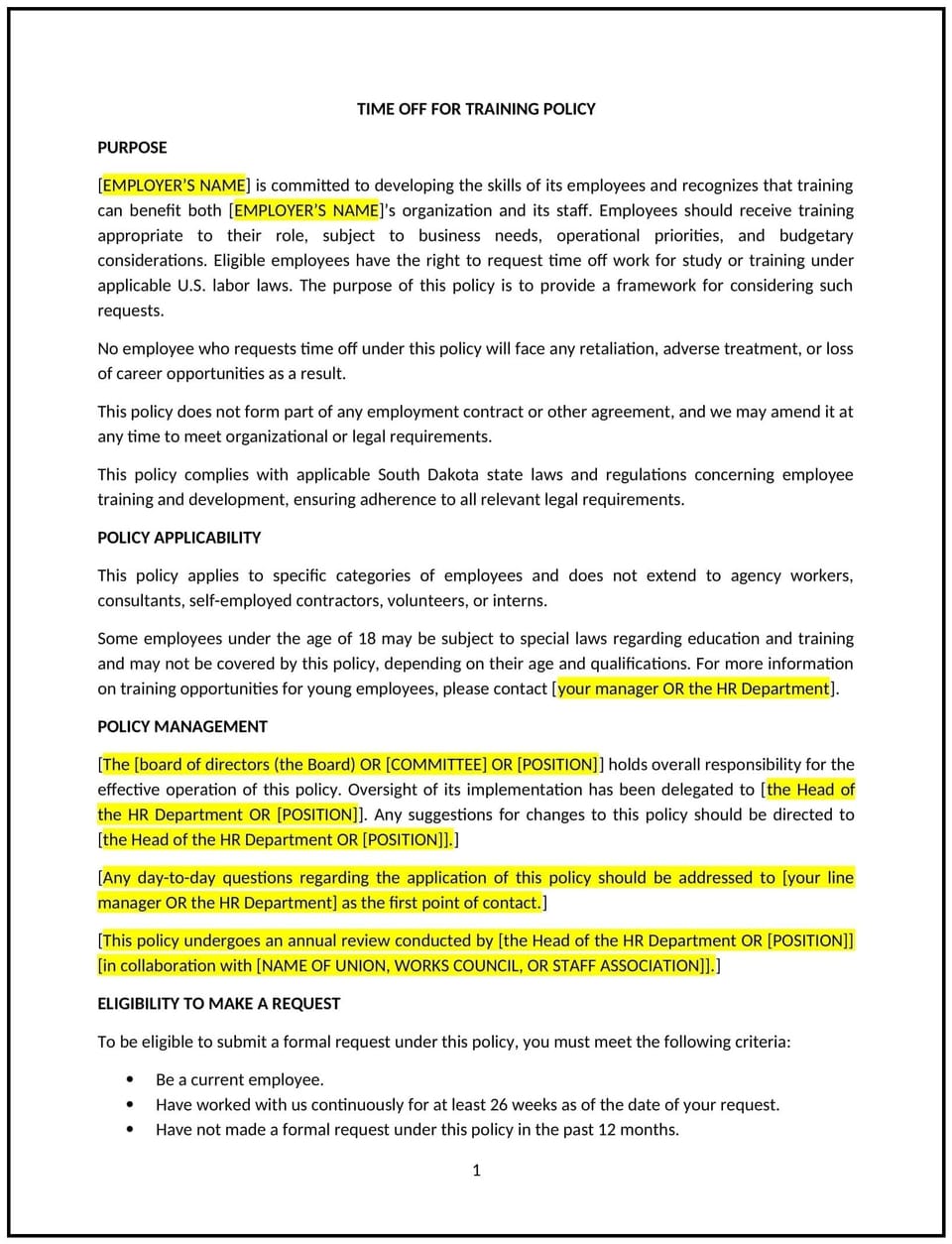Time off for training policy (South Dakota): Free template

Time off for training policy (South Dakota)
This time off for training policy is designed to help South Dakota businesses establish guidelines for employees who need time off to attend professional development or training programs. It outlines procedures for requesting leave, approval processes, and expectations for applying new skills in the workplace.
By adopting this policy, businesses can support employee growth, enhance skill development, and align with general best practices for workforce development.
How to use this time off for training policy (South Dakota)
- Define eligible training: Specify the types of training programs that qualify for time off, such as certifications, workshops, or courses.
- Set request procedures: Provide steps for employees to request time off, including required notice and approval processes.
- Address pay during leave: Clarify whether employees will be paid during their absence for training, based on company policy.
- Establish expectations: Outline how employees should apply new skills or knowledge gained from training in their roles.
- Ensure job protection: Guarantee that employees will return to the same or an equivalent position after completing their training.
- Train managers: Educate supervisors on handling training requests and maintaining workflow during employee absences.
- Review and update: Assess the policy annually to ensure it aligns with evolving business needs and employee development goals.
Benefits of using this time off for training policy (South Dakota)
This policy offers several advantages for South Dakota businesses:
- Supports employee growth: Encourages employees to pursue professional development opportunities, enhancing their skills and knowledge.
- Boosts productivity: Equips employees with new skills that can improve job performance and efficiency.
- Aligns with best practices: Demonstrates a commitment to workforce development and employee engagement.
- Enhances retention: Shows employees that the business values their career growth, increasing loyalty and satisfaction.
- Reduces skill gaps: Helps address skill shortages by investing in employee training and development.
Tips for using this time off for training policy (South Dakota)
- Communicate the policy: Share the policy with employees and include it in the employee handbook.
- Provide training: Educate managers on handling training requests and maintaining workflow during employee absences.
- Monitor compliance: Regularly review training requests to ensure adherence to the policy.
- Address issues promptly: Take corrective action if requests are mishandled or denied improperly.
- Update regularly: Review the policy annually to ensure it aligns with evolving business needs and employee development goals.
Q: How does this policy benefit businesses?
A: It supports employee growth, boosts productivity, and aligns with best practices for workforce development.
Q: What types of training qualify for time off?
A: Eligible training may include certifications, workshops, courses, or other professional development programs relevant to the employee’s role.
Q: Are employees paid during their absence for training?
A: This depends on the business’s policy. Some businesses provide paid leave for approved training programs.
Q: Can businesses require employees to share what they learned from training?
A: Yes, businesses can ask employees to share insights or apply new skills in their roles as part of the training policy.
Q: How often should businesses review this policy?
A: Businesses should review the policy annually or as needed to ensure it aligns with evolving business needs and employee development goals.
This article contains general legal information and does not contain legal advice. Cobrief is not a law firm or a substitute for an attorney or law firm. The law is complex and changes often. For legal advice, please ask a lawyer.


